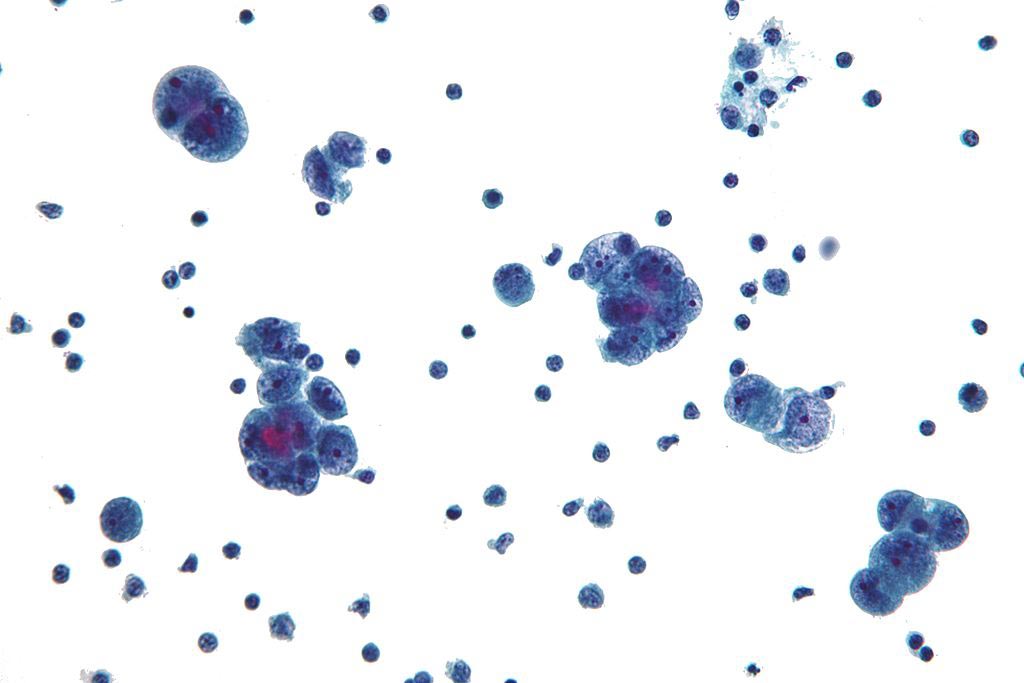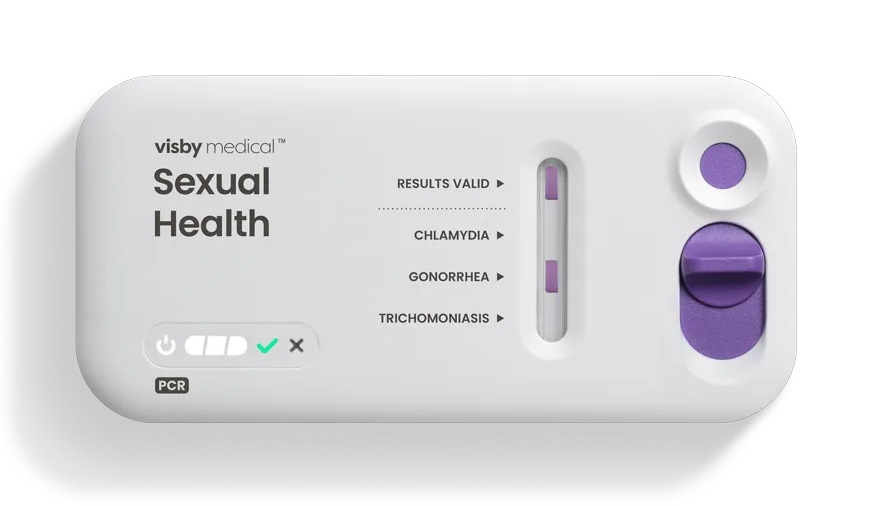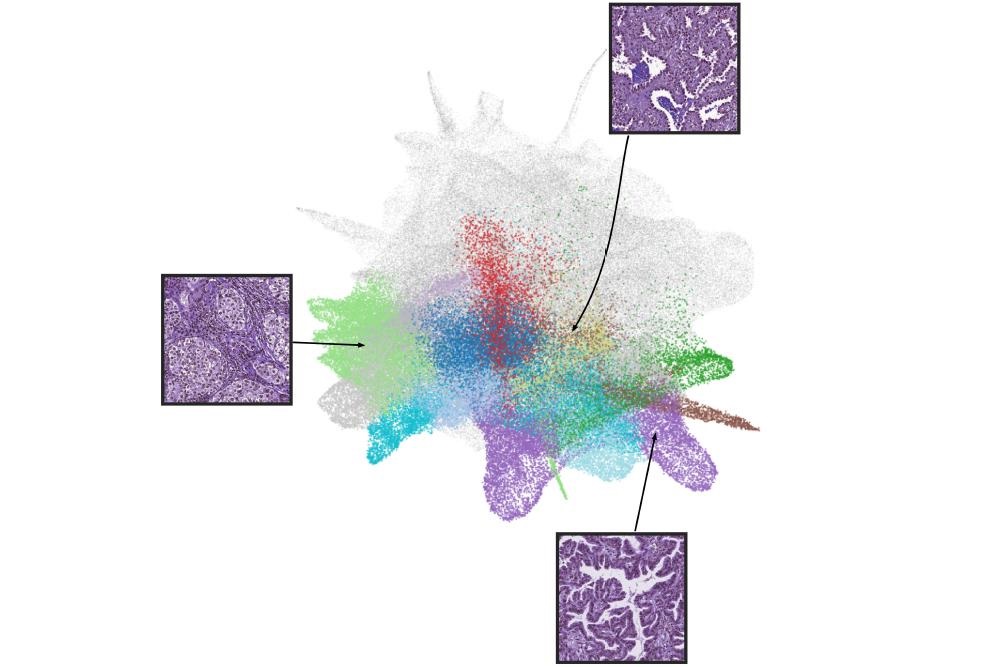Protein Panel Accurately Differentiates Forms of Ovarian Tumors
|
By LabMedica International staff writers Posted on 20 May 2019 |

Image: A micrograph of a high-grade serous ovarian carcinoma (Photo courtesy of Wikimedia Commons).
A panel of eight proteins was found that distinguishes between the milder endometrioid (EC) and more deadly high-grade serous (HGSC) forms of ovarian cancer with 99.2% accuracy.
Ovarian carcinomas are a group of distinct diseases classified by histotypes, which describe the range of tissue types that arise during the growth of the tumor. As histotype-specific treatment improves, accurate classification of the disease will become critical.
To uncover differences between the two most common histotypes (EC and HGSC), investigators at the University of Alberta (Canada) performed label-free quantitative proteomics on freshly frozen tumor tissues (10 samples of each histotype). Eight candidate protein biomarkers specific to EC were validated by immunohistochemistry using tissue microarrays representing 361 cases of either EC or HGSC.
Results revealed over 500 proteins that were expressed differentially between EC and HGSC tumor proteomes. A ranked set of 106 proteins was sufficient to correctly discriminate 90% of samples. Immunohistochemistry validated KIAA1324 as the most discriminatory novel biomarker for EC. Expression of the KIAA1324 gene is induced by estrogen and the encoded protein has been characterized as a transmembrane protein. This protein has been found to correlate with survival in certain carcinomas and may be important for cellular response to stress.
An eight-marker panel was found to exhibit superior performance for discriminating EC from HGSC compared to the current standard of WT1 (Wilms tumor protein) plus TP53 (tumor suppressor p53), improving the classification rate for HGSC from 90.7% to 99.2%. Other specific diagnostic markers were also significantly associated with favorable prognosis within EC suggesting biological heterogeneity within this histotype.
"One of the issues with ovarian cancer is that we cannot fully decipher between subtypes," said first author Dr. Lynne Postovit, associate professor of oncology at the University of Alberta. "This is an important problem because the different subtypes should be treated differently. That does not sound like a big deal, but the difference in the ways that women with endometrioid versus high-grade serous are treated is significant."
"The relevance is if you know what you are looking at, you take a precision medicine approach to better tailor the treatment to the patient, so they have potentially less side effects," said Dr. Postovit. "This is what personalized medicine is all about--starting to look at each patient's cancer differently. Not knowing with complete certainty which form of cancer the patient has means that oncologists have to go with the harshest treatment regardless."
The ovarian cancer biomarker panel was described in the April 12, 2019, online edition of the journal Clinical Cancer Research.
Related Links:
University of Alberta
Ovarian carcinomas are a group of distinct diseases classified by histotypes, which describe the range of tissue types that arise during the growth of the tumor. As histotype-specific treatment improves, accurate classification of the disease will become critical.
To uncover differences between the two most common histotypes (EC and HGSC), investigators at the University of Alberta (Canada) performed label-free quantitative proteomics on freshly frozen tumor tissues (10 samples of each histotype). Eight candidate protein biomarkers specific to EC were validated by immunohistochemistry using tissue microarrays representing 361 cases of either EC or HGSC.
Results revealed over 500 proteins that were expressed differentially between EC and HGSC tumor proteomes. A ranked set of 106 proteins was sufficient to correctly discriminate 90% of samples. Immunohistochemistry validated KIAA1324 as the most discriminatory novel biomarker for EC. Expression of the KIAA1324 gene is induced by estrogen and the encoded protein has been characterized as a transmembrane protein. This protein has been found to correlate with survival in certain carcinomas and may be important for cellular response to stress.
An eight-marker panel was found to exhibit superior performance for discriminating EC from HGSC compared to the current standard of WT1 (Wilms tumor protein) plus TP53 (tumor suppressor p53), improving the classification rate for HGSC from 90.7% to 99.2%. Other specific diagnostic markers were also significantly associated with favorable prognosis within EC suggesting biological heterogeneity within this histotype.
"One of the issues with ovarian cancer is that we cannot fully decipher between subtypes," said first author Dr. Lynne Postovit, associate professor of oncology at the University of Alberta. "This is an important problem because the different subtypes should be treated differently. That does not sound like a big deal, but the difference in the ways that women with endometrioid versus high-grade serous are treated is significant."
"The relevance is if you know what you are looking at, you take a precision medicine approach to better tailor the treatment to the patient, so they have potentially less side effects," said Dr. Postovit. "This is what personalized medicine is all about--starting to look at each patient's cancer differently. Not knowing with complete certainty which form of cancer the patient has means that oncologists have to go with the harshest treatment regardless."
The ovarian cancer biomarker panel was described in the April 12, 2019, online edition of the journal Clinical Cancer Research.
Related Links:
University of Alberta
Latest Pathology News
- Self-Taught AI Tool Diagnoses and Predicts Severity of Common Lung Cancer
- Novel AI-Powered Method for Tissue Analysis Improves Understanding of Disease Pathology
- Noninvasive Technology Detects Rare Cancer Cells in Blood
- AI Tool Detects Tiny Protein Clumps in Microscopy Images in Real-Time
- New Tool Enables Better Classification of Inherited Disease-Causing Variants
- Groundbreaking CRISPR Screen Technology Rapidly Determines Disease Mechanism from Tissues
- New AI Tool Classifies Brain Tumors More Quickly and Accurately
- AI Integrated With Optical Imaging Technology Enables Rapid Intraoperative Diagnosis
- HPV Self-Collection Solution Improves Access to Cervical Cancer Testing
- Hyperspectral Dark-Field Microscopy Enables Rapid and Accurate Identification of Cancerous Tissues
- AI Advancements Enable Leap into 3D Pathology
- New Blood Test Device Modeled on Leeches to Help Diagnose Malaria
- Robotic Blood Drawing Device to Revolutionize Sample Collection for Diagnostic Testing
- Use of DICOM Images for Pathology Diagnostics Marks Significant Step towards Standardization
- First of Its Kind Universal Tool to Revolutionize Sample Collection for Diagnostic Tests
- AI-Powered Digital Imaging System to Revolutionize Cancer Diagnosis
Channels
Clinical Chemistry
view channel
New ADLM Guidance Provides Expert Recommendations on Clinical Testing For Respiratory Viral Infections
Respiratory tract infections, predominantly caused by viral pathogens, are a common reason for healthcare visits. Accurate and swift diagnosis of these infections is essential for optimal patient management.... Read more
3D Printed Point-Of-Care Mass Spectrometer Outperforms State-Of-The-Art Models
Mass spectrometry is a precise technique for identifying the chemical components of a sample and has significant potential for monitoring chronic illness health states, such as measuring hormone levels... Read more.jpg)
POC Biomedical Test Spins Water Droplet Using Sound Waves for Cancer Detection
Exosomes, tiny cellular bioparticles carrying a specific set of proteins, lipids, and genetic materials, play a crucial role in cell communication and hold promise for non-invasive diagnostics.... Read more
Highly Reliable Cell-Based Assay Enables Accurate Diagnosis of Endocrine Diseases
The conventional methods for measuring free cortisol, the body's stress hormone, from blood or saliva are quite demanding and require sample processing. The most common method, therefore, involves collecting... Read moreHematology
view channel
Next Generation Instrument Screens for Hemoglobin Disorders in Newborns
Hemoglobinopathies, the most widespread inherited conditions globally, affect about 7% of the population as carriers, with 2.7% of newborns being born with these conditions. The spectrum of clinical manifestations... Read more
First 4-in-1 Nucleic Acid Test for Arbovirus Screening to Reduce Risk of Transfusion-Transmitted Infections
Arboviruses represent an emerging global health threat, exacerbated by climate change and increased international travel that is facilitating their spread across new regions. Chikungunya, dengue, West... Read more
POC Finger-Prick Blood Test Determines Risk of Neutropenic Sepsis in Patients Undergoing Chemotherapy
Neutropenia, a decrease in neutrophils (a type of white blood cell crucial for fighting infections), is a frequent side effect of certain cancer treatments. This condition elevates the risk of infections,... Read more
First Affordable and Rapid Test for Beta Thalassemia Demonstrates 99% Diagnostic Accuracy
Hemoglobin disorders rank as some of the most prevalent monogenic diseases globally. Among various hemoglobin disorders, beta thalassemia, a hereditary blood disorder, affects about 1.5% of the world's... Read moreImmunology
view channel.jpg)
AI Tool Predicts Cancer Patients’ Response to Immunotherapy
Immune checkpoint inhibitors are a form of immunotherapy drug that enables immune cells to target and destroy cancer cells. At present, the Food and Drug Administration has approved two predictive biomarkers... Read more
Molecular Profiling Improves Diagnosis for Children with High Risk Cancers
Cancer remains the leading cause of disease-related death among children in most developed nations, and approximately one-fourth of these patients are diagnosed with aggressive, high-risk, or relapsed... Read moreMicrobiology
view channel
POC STI Test Shortens Time from ED Arrival to Test Results
In a 2024 sexually transmitted infections (STIs) surveillance report by the World Health Organization (WHO), over 2.5 million cases were recorded, alongside a rise in the inappropriate use of antibiotics... Read more
Integrated Solution Ushers New Era of Automated Tuberculosis Testing
Tuberculosis (TB) is responsible for 1.3 million deaths every year, positioning it as one of the top killers globally due to a single infectious agent. In 2022, around 10.6 million people were diagnosed... Read more
Automated Sepsis Test System Enables Rapid Diagnosis for Patients with Severe Bloodstream Infections
Sepsis affects up to 50 million people globally each year, with bacteraemia, formerly known as blood poisoning, being a major cause. In the United States alone, approximately two million individuals are... Read moreEnhanced Rapid Syndromic Molecular Diagnostic Solution Detects Broad Range of Infectious Diseases
GenMark Diagnostics (Carlsbad, CA, USA), a member of the Roche Group (Basel, Switzerland), has rebranded its ePlex® system as the cobas eplex system. This rebranding under the globally renowned cobas name... Read morePathology
view channel
Self-Taught AI Tool Diagnoses and Predicts Severity of Common Lung Cancer
A computer program powered by artificial intelligence (AI) and trained on nearly half a million tissue images can effectively diagnose cases of adenocarcinoma, the most prevalent type of lung cancer.... Read more
Novel AI-Powered Method for Tissue Analysis Improves Understanding of Disease Pathology
Scientists at Brown University (Providence, RI, USA) and the University of Michigan (Ann Arbor, MI, USA) have created a groundbreaking computational technique to examine complex tissue data, potentially... Read moreTechnology
view channel
Microneedle Patch Detects Skin Cancer Early
Wearable bioelectronics has emerged as a significant innovation in healthcare, especially in the field of biosensing, providing a new method to monitor individual health for both diagnostic and therapeutic purposes.... Read more
New Diagnostic System Achieves PCR Testing Accuracy
While PCR tests are the gold standard of accuracy for virology testing, they come with limitations such as complexity, the need for skilled lab operators, and longer result times. They also require complex... Read moreIndustry
view channel
Roche and Hitachi High-Tech Extend 46-Year Partnership for Breakthroughs in Diagnostic Testing
Roche (Basel, Switzerland) and Hitachi High-Tech (Tokyo, Japan) have renewed their collaboration agreement, committing to a further 10 years of partnership. This extension brings together their long-standing... Read more
Danaher and Johns Hopkins University Collaborate to Improve Neurological Diagnosis
Unlike severe traumatic brain injury (TBI), mild TBI often does not show clear correlations with abnormalities detected through head computed tomography (CT) scans. Consequently, there is a pressing need... Read more
Beckman Coulter and MeMed Expand Host Immune Response Diagnostics Partnership
Beckman Coulter Diagnostics (Brea, CA, USA) and MeMed BV (Haifa, Israel) have expanded their host immune response diagnostics partnership. Beckman Coulter is now an authorized distributor of the MeMed... Read more_1.jpg)












.jpg)



